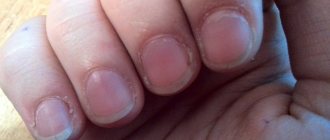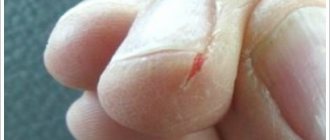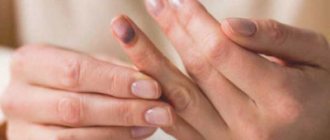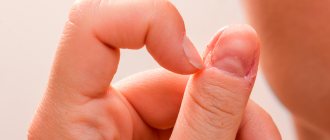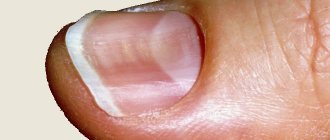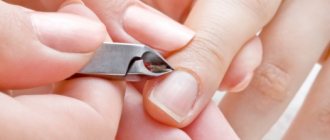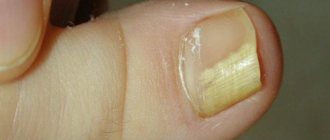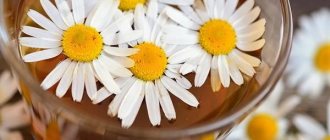Causes of cracks
The skin on the fingers near the nails can crack for a variety of reasons.
External reasons:
- poor skin care in this area;
- mechanical damage (wounds);
- sudden changes in temperature, cold;
- exposure to household chemicals;
- long contact with water.
Internal reasons:
- disorders of the thyroid gland;
- skin diseases (eczema, psoriasis, fungus);
- lack of vitamins A, B7, E, Omega-3, magnesium;
- parasite infection;
- allergy;
- pregnancy;
- neurological disorders;
- various chronic diseases (gastritis, depression, etc.).
Cracks can occur both along and across the nail plate. For successful treatment it is necessary to identify the true cause of their appearance. Cosmetic products alone will not help if you have any chronic untreated disease.
Why does the skin around my nails peel?
The skin around the nail cracks and peels off for various reasons, but often the phenomenon is associated with some external influences. For example, in winter people dress warmly, but periodically have to take off their gloves in the cold to perform certain actions. At these moments, the skin is exposed to temperatures that negatively affect its condition.
Weather
If you are wondering why the skin on your fingers and nails is peeling, do not rush to see a doctor. Often the complication is associated with weather conditions, not only with negative temperatures, but also with the wind, which dries out the hands and makes the skin defenseless.
Chemical influences
Sometimes the skin around the fingernails peels off due to chemicals contained in our usual hygiene products. Some of them cause dry skin of the fingers. Cheap dishwashing detergents have a particularly negative effect on the condition of the epidermis around the nails, so it is recommended to wash them with rubber gloves.
Even blackboard chalk or nail polish can worsen the condition of the skin around your nails and cause them to peel.
Constant contact with water
Surprisingly, water with dry skin cannot improve the situation, but only aggravates it. Regular contact with water dries out the epidermis and helps wash away the natural protective layer. Hot water is especially harmful; with constant exposure to it, the skin around the nails often peels off.
Cosmetics
If you are wondering why the skin around your fingernails is peeling, reconsider the cosmetics you use. Some products that are designed to restore and nourish the skin are simply not suitable for a particular person, causing itching, allergies, burning and dryness. Cosmetics that have expired are especially harmful.
Treatment with medications
Healing ointments and vitamins (for example, Aevit) will help cope with the problem. If the skin near the nail cracks due to any disease, then it is necessary to treat it. Otherwise, the cracks will torment you again and again.
Creams, ointments, balms
In order to get rid of a crack near the nail, you can use healing external agents. Here are some good ones:
- Ointment Radevit. Contains vitamins A, E, D.
- Balm Rescuer. Contains natural ingredients. Cleanses and restores the skin.
- Balm Guardian . A natural remedy that has a disinfecting and healing effect.
- Cream or ointment D-Panthenol. Has a regenerating, anti-inflammatory effect.
- Bepanten cream or ointment. Normalizes cellular metabolism, heals damaged skin.
- Balm Ambulance . The composition includes olive and sea buckthorn oils, as well as vitamins A and E.
Be sure to read:
What vitamins does the body lack if sticking appears on the lips?
To intensively moisturize the skin, you can use hand creams with urea. Follow the link to find the TOP 10 products.
Glue BF-6
Using medical glue BF-6, you can sort of seal the wound. It is applied to clean and dry skin along the entire length of the wound (a couple of drops is enough). Wait a few minutes for the glue to dry. The edges of the crack are well fixed, and its bottom gradually heals.
After 5-7 days the glue can be removed. During this time, do not use any other healing agents.
After removing the glue, it is advisable to conduct a course of baths, as well as choose proper care for the skin of your hands.
Masks
Peeling skin
If, in addition to peeling, cracks also appear on your fingers, they can be eliminated with the help of special creams sold in pharmacies. They usually contain vitamin E, which promotes speedy recovery, as well as other components. The most effective such creams are Radevit, F-99, as well as simple healing agents - Bepanten, D-Panthenol, etc. For the most severe damage - Actovegin. Dry skin around the nails, as well as on all hands, among other things, is intensively moisturized.
However, if you are a fan of traditional medicine, then there are quite effective “grandmother’s” recipes. The most interesting of them involves combining honey and glycerin in a ratio of 1 to 2. You need to add a little flour to thicken the composition and apply the mixture to your nails for 20 minutes. You can replace glycerin with any oil, but in this case the mask should be left overnight.
Cosmetic wax used to seal the area can also help. You need to melt it in a water bath to the maximum temperature that you can withstand. Dip your fingertips into the mixture and wait until the wax hardens. After this, put on cotton gloves and go to bed. The wax should be removed in the morning.
Traditional recipes for cracks
To combat the problem of cracks around the nails, you can use the following folk remedies:
- Shilajit-based ointment. Dissolve 2 tablets in a small amount of water. Apply the resulting mixture to the skin, rinse after drying.
- Egg ointment. Mix 2 tsp. cottage cheese, yolk, half tbsp. sunflower oil. Apply to the affected area, after drying, rinse with warm water.
- Bath with tea tree oil. Add 10 drops of oil to a glass of warm water. Pour the water into a small container. Keep your hands in the water for about ten minutes.
- Bath with oils and sea salt. Add a few drops of oil to the salt solution (2 tablespoons per 1 liter) (you can take olive, almond, peach). After the procedure, dry your hands with a paper towel.
- Oil bath. Add a few drops of lemon juice and 2 capsules of aevit to half a glass of olive oil. Soak your hands in the mixture for about 10-15 minutes.
Diseases of the body
Cracks around nails
- Hormonal imbalances;
- Metabolic disease;
- Diseases of the digestive system and gastrointestinal tract;
- Eczema (may appear like this in the early stages);
- Thyroid diseases.
If the cause of the cracks is one of these diseases, then you should not self-medicate. In addition to peeling, skin cracks may also occur. They can bleed, hurt, and cause significant discomfort. If they do not go away long enough, it is better to contact a specialist.
Nutrition and drinking regime
Nutrition should be balanced (balance of proteins, fats, carbohydrates) and include vitamins and microelements beneficial for the skin. Among them are:
- seafood (fatty fish, oysters, shellfish) - rich in Omega-3, moisturize and nourish the skin, promote the healing of cracks;
- citrus fruits (oranges, grapefruit, lemons), bell peppers - contain vitamin C, which is necessary to maintain healthy skin;
- green and red vegetables (carrots, tomatoes, herbs, bell peppers) - contain vitamin A, which has an antioxidant effect and fights dryness, peeling, and cracks. This vitamin is also found in pork and beef liver, cod, salmon, butter and milk;
- nuts are rich in vitamin E, which rejuvenates, eliminates flaking and cracks, and prevents dry skin;
- onion - includes mineral salts, proteins and fats that are beneficial for the epidermis, organic acids, vitamins B, E, essential oils.
Drinking regime is very important. You should drink enough water per day. For an adult, the norm is approximately 1.5-2 liters.
What to do to prevent your nails from peeling off
Below are some tips that may be helpful in preventing peeling nails:
- In case of nutritional deficiencies or periods of intense stress, you can take multivitamin supplements and mineral salts to enhance the keratin saturation of your nails.
- If you plan to use harsh detergents and cleaners, always wear protective gloves.
- If you want to have a flawless manicure and maintain healthy nails, turn to professionals who use quality products and who know how to avoid nail damage.
- In the case of a fungal nail infection, you can buy remedies at the pharmacy to treat the problem. However, it is recommended to consult a physician and perform a dermatological examination before using any medical product.
- Eat a diet that contains foods rich in vitamins and minerals.
- Drink at least 1.5-2 liters of water per day to avoid dehydration.
- Avoid cigarette smoke, which increases free radicals and oxidative stress.
- If you do your manicure at home, try not to use solvents with acetone, do not cut your nails with scissors (use nail clippers), use a file that is not too hard, and use a good quality polish.
- Avoid, as much as possible, biting your nails and putting your fingers in your mouth.
Further prevention
Be sure to follow simple rules so that after treatment the problem (dryness and cracks around the nails) does not return:
- take vitamins, eat more vegetables and fruits (if there are no contraindications);
- After contact with water, dry your hands thoroughly and lubricate them with cream;
- use hypoallergenic cosmetics and household chemicals;
- during cold weather, be sure to wear gloves or mittens;
- treat chronic diseases in a timely manner;
- do not bite your nails or the area around them;
- use only your own nail scissors;
- take care of the skin of your hands, periodically take baths, etc.
Be sure to read:
How to treat sores on the head under the hair
1.General information
Such phrases as “healthy shine of hair”, “silky skin”, “strong nails”, etc. - often used in advertising and literature. Nature itself provides certain optical, tactile, physical-mechanical (firmness, strength, elasticity) characteristics of the external structures of the body, which are unconsciously perceived as signs of health, and therefore beauty. And on the contrary, the loss of these characteristics signals one or another problem.
Dry skin, brittle nails and hair that has begun to fall out are not a cosmetic problem. This triad of symptoms is well known in many areas of medicine, and the list of diseases in the clinical picture of which it is included is surprisingly wide. This includes pathology of the gastrointestinal tract, and diseases of the kidneys, respiratory organs, and oral cavity; chronic infectious and inflammatory processes, dysfunction of the hematopoietic and immune systems; a number of neuropsychiatric disorders (endogenous depression, anorexia, etc.). There are even more known external and situational risk factors: environmental and occupational hazards, stress, bad habits, hypovitaminosis, overwork, taking medications, household chemicals and personal care products, etc.
However, upon careful study of the problem, it turns out that all these causes and factors, no matter what area they belong to, ultimately come down to metabolic disorders. In turn, these complex biochemical processes are under the control of neurohumoral regulation, which is carried out by the interaction of the nervous system and its faithful “executor” - the endocrine system, i.e. a complex of endocrine glands that produce hormone regulators. Some changes in the skin, nails and hair are inherent in almost any hormonal disorder (diabetes mellitus, genetic, inflammatory, oncological diseases of the endocrine glands, age-related changes, etc.). But in cases where there are no more severe and obvious symptoms, you should pay attention to the condition of the thyroid gland. This dicotyledonous, butterfly-shaped (sometimes compared to a logo) endocrine gland is located in the front of the neck and is involved in a number of key physiological processes - bone formation, growth and maturation, control of iodine in the body, provision of cardiovascular, reproductive, digestive, mental activity. Thyroid hormones - thyroxine, triiodothyronine, calcitonin - must be in a strictly defined concentration and balance, any displacements of which (hypo- and hyperthyroidism, thyrotoxicosis) have an extremely detrimental effect on the condition of the entire organism as a whole. And the first, preclinical signs are often those phenomena that are included in the title of the article.
A must read! Help with treatment and hospitalization!
